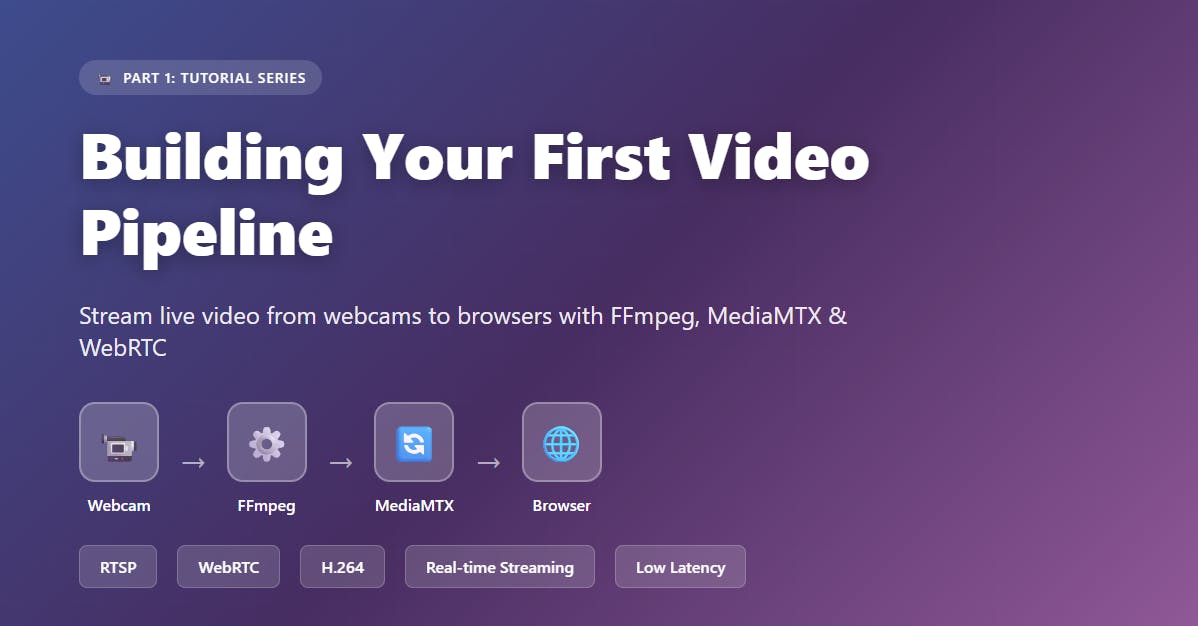Introduction
Imagine this: You’re tasked with building a web application that displays live video feeds from security cameras, IoT devices, or webcams. Simple enough, right? You quickly discover that while HTML5 video works great for pre-recorded content, the world of real-time streaming is a maze of protocols, codecs, and compatibility issues that can turn a very “simple” feature into weeks of frustration.
The core problem is interestingly simple: cameras speak RTSP, but browsers don’t. Most IP cameras and professional video equipment use RTSP (Real Time Streaming Protocol) to broadcast their feeds. That’s because it’s reliable, has low latency, and is perfect for direct connections. But when you try to display that same stream in a web browser, you hit a wall. Modern browsers have dropped RTSP support entirely for security reasons since around 2010-2015, leaving developers scrambling for solutions.
This is where the magic happens.
FFmpeg, the Swiss Army knife of video processing, and MediaMTX, a modern streaming server that acts as a universal translator between different video protocols. Together, they form the backbone of countless video applications, from Netflix’s encoding pipeline to your local security system’s web interface.
In this series, we are going to build a complete, production-ready video streaming pipeline from the ground up. By the end of this first article, you’ll have a live webcam feed streaming directly in your browser with remarkably low latency. Let’s dive in.
The Tools of the Trade
FFmpeg: The Universal Video Swiss Army Knife
FFmpeg is arguably one of the most important pieces of software you’ve never heard of. It powers video processing in applications ranging from VLC media player to professional broadcast systems. At its core, FFmpeg is a command-line tool that can read virtually any video or audio format and convert it to virtually any other format.
The FFmpeg workflow follows a predictable pattern:
- Demuxing: Separating video and audio streams from container formats
- Decoding: Converting compressed data into raw video frames and audio samples
- Filtering: Applying transformations like scaling, cropping, or color correction
- Encoding: Compressing the processed data using codecs like H.264 or VP9
- Muxing: Packaging the encoded streams into output containers
For our streaming pipeline, FFmpeg will serve as the ingestion engine. It will capture video from sources like webcams or files, encode it efficiently, and push it to our streaming server using protocols like RTSP or RTMP (Real-Time Messaging Protocol).
MediaMTX: The Modern Streaming Gateway
While FFmpeg excels at processing video, it cannot serve multiple clients simultaneously. That’s where MediaMTX comes in. MediaMTX is a modern, lightweight streaming server that acts as a universal media gateway.
Think of MediaMTX as a protocol translator and traffic manager:
- It accepts incoming streams via RTSP, RTMP, WebRTC, or HLS
- It can re-package those streams into different formats for different clients
- It handles authentication, load balancing, and client management
- Most importantly for web developers, it can serve RTSP streams as WebRTC, making them accessible to browsers
The beauty of MediaMTX lies in its simplicity. A single binary with a YAML configuration file can handle complex streaming scenarios that would require multiple specialized servers in traditional setups.
Hands-On Setup
Before we start building, let’s get our tools installed.
Installing FFmpeg
As of the time of writing this article, the latest ffmpeg release is v8.0, and that is what I will be using.
On Ubuntu/Debian:
sudo apt-update
sudo apt install autoconf automake build-essential pkg-config libx264-dev libvpx-dev libfdk-aac-dev
git clone https://git.ffmpeg.org/ffmpeg.git ffmpeg
cd ffmpeg
./configure --enable-gpl --enable-libx264 --enable-nonfree
make -j$(nproc)
make install
On MacOS (using Homebrew):
brew install ffmpeg
On Windows:
Download FFmpeg:
- Go to https://ffmpeg.org/download.html
- Click on “Windows”
- Choose the gyan.dev build (recommended)
- Download the latest release version
Extract the Files:
- Extract the downloaded zip file to
C:ffmpeg - You should see folders like
bin,doc, etc.
Add to System PATH:
- Press Windows + R, type
sysdm.cpl, press Enter - Click Advanced tab → Environment Variables
- Under System Variables, find and select Path
- Click Edit → New
- Add:
C:ffmpegbin - Click OK on all windows
Verify Installation:
ffmpeg -version
You should see version information and a list of supported codecs and formats.
Installing MediaMTX
As of the time of writing this article, the latest ffmpeg release is v1.15.0, and that is what I will be using.
MediaMTX distributes as a single binary, making installation straightforward:
MacOS and Linux Installation:
# Download and extract (replace 'linux' with 'darwin' for MacOS)
wget https://github.com/bluenviron/mediamtx/releases/latest/download/mediamtx_v1.15.0_linux_amd64.tar.gz
tar -xzf mediamtx_v1.15.0_linux_amd64.tar.gz
# Make executable and test
chmod +x mediamtx
# Add to system PATH
sudo mv mediamtx /usr/local/bin/
# Run it to confirm installation
mediamtx
Windows Installation:
# Download and extract
curl -L -O https://github.com/bluenviron/mediamtx/releases/latest/download/mediamtx_v1.15.0_windows_amd64.tar.gz
# Extract to mediamtx_v1.15.0_windows_amd64 folder
# Test run
cd mediamtx_v1.15.0_windows_amd64
./mediamtx.exe
# Add to PATH
mkdir C:Users{YOUR_USER}bin
Move-Item .mediamtx.exe C:Users{YOUR_USER}bin
Add to Windows PATH: Windows + R → ==sysdm.cpl== → Advanced → Environment Variables → System Variables → Path → Edit → New → Add C:Users{YOUR_USER}bin
Note: Windows Defender may flag the download – temporarily disable if needed.
When you run MediaMTX for the first time, you’ll see output like:
MediaMTX is now running and ready to accept streams.
Project 1: Streaming a Video File
Let’s start simple by streaming a video file. This simulates a live source and helps us understand the basic pipeline without the complexity of hardware interfaces.
First, create a basic MediaMTX configuration file. Create mediamtx.yml:
# Basic MediaMTX configuration
paths:
test_video:
source: publisher
This configuration creates a path called test_video that accepts published streams from any source.
Run mediamtx with the config file you created:
# In the directory you created the mediamtx.yml
mediamtx mediamtx.yml
Now, let’s use FFmpeg to stream a video file to MediaMTX. You’ll need a video file for testing. Any MP4, AVI, or MOV file will work:
ffmpeg -re -i your_video.mp4 -c:v libx264 -preset fast -c:a aac -f rtsp rtsp://localhost:8554/test_video
Let’s break down this command:
-re: Read input at its native frame rate (essential for live streaming)-i your_video.mp4: Input file-c:v libx264: Use H.264 video codec (widely compatible)-preset fast: Encoding speed vs. compression trade-off-c:a aac: Use AAC audio codec-f rtsp: Output format is RTSPrtsp://localhost:8554/test_video: Destination URL
If everything works correctly, you’ll see FFmpeg output showing frame processing statistics.
Testing Your Stream
Open VLC Media Player and:
- Go to Media → Open Network Stream
- Enter:
rtsp://localhost:8554/test_video - Click Play
You should see your video playing! This confirms that MediaMTX is receiving the stream from FFmpeg and serving it via RTSP.
Project 2: Streaming a Webcam
Now, let’s capture something live. We’ll stream directly from your webcam to create a real-time video feed.
First, let’s add a new path in our mediamtx config:
# Basic MediaMTX configuration
paths:
test_video:
source: publisher
webcam:
source: publisher
Now we need to identify your webcam device:
On Linux:
# List video devices
ls /dev/video*
# Usually /dev/video0 for the first webcam
On MacOS:
# List available devices
ffmpeg -f avfoundation -list_devices true -i ""
On Windows:
# List available devices
ffmpeg -list_devices true -f dshow -i dummy
# OR
Get-PnpDevice -Class Camera | Select-Object FriendlyName, Status
You’ll see output listing available cameras and microphones. Note the device index (usually 0 for the built-in camera).
Now, let’s stream your webcam:
On Windows:
ffmpeg -f dshow -rtbufsize 100M -i video="Integrated Webcam" -c:v libx264 -preset ultrafast -tune zerolatency -f rtsp rtsp://localhost:8554/webcam
Let’s break down this command:
Input Parameters:
-f dshow– Use DirectShow input format (Windows-specific for cameras/microphones)-rtbufsize 100M– Set real-time buffer size to 100MB (prevents dropped frames)-i video="Integrated Webcam"– Input source: video device named “Integrated Webcam”
Output Parameters:
-c:v libx264– Video codec: use H.264 encoder-preset ultrafast– Encoding preset: prioritize speed over compression quality-tune zerolatency– Optimize encoding for real-time streaming (minimal buffering)-f rtsp– Output format: Real Time Streaming Protocolrtsp://localhost:8554/webcam– Output destination: local RTSP server on port 8554, path “/webcam”
On MacOS:
ffmpeg -f avfoundation -framerate 30 -video_size 1280x720 -i "0" -c:v libx264 -preset ultrafast -tune zerolatency -f rtsp rtsp://localhost:8554/webcam
Input Parameters:
-f avfoundation– Use AVFoundation input format (macOS-specific for cameras/microphones)-framerate 30– Capture at 30 frames per second-video_size 1280x720– Set capture resolution to 1280×720 (720p)-i "0"– Input source: device index 0 (first camera device)
Output Parameters: (same as Windows)
-c:v libx264– Video codec: H.264 encoder-preset ultrafast– Fastest encoding preset-tune zerolatency– Real-time streaming optimization-f rtsp– RTSP output formatrtsp://localhost:8554/webcam– RTSP server destination
On Linux:
ffmpeg -f v4l2 -i /dev/video0 -c:v libx264 -preset ultrafast -tune zerolatency -c:a aac -f rtsp rtsp://localhost:8554/webcam
Input Parameters:
-f v4l2– Use Video4Linux2 input format (Linux-specific for cameras)-i /dev/video0– Input source: first video device in Linux (/dev/video0)
Output Parameters:
-c:v libx264– Video codec: H.264 encoder-preset ultrafast– Fastest encoding preset-tune zerolatency– Real-time streaming optimization-c:a aac– Audio codec: Advanced Audio Coding (AAC)-f rtsp– RTSP output formatrtsp://localhost:8554/webcam– RTSP server destination
Note: We’re using the path /webcam instead of /test_video. Test this stream in VLC using rtsp://localhost:8554/webcam. You should see your live webcam feed with minimal delay!
Project 3: The Magic of WebRTC
Here’s where things get exciting. While RTSP works great for applications like VLC, it won’t work in web browsers. But MediaMTX has a superpower: it can automatically convert RTSP streams to WebRTC, which browsers understand perfectly.
Let’s enable WebRTC in MediaMTX. Update your mediamtx.yml configuration:
# Basic MediaMTX configuration
webrtc: yes
webrtcAddress: :8889
webrtcEncryption: no
webrtcAllowOrigin: '*'
webrtcLocalUDPAddress: :8189
webrtcIPsFromInterfaces: yes
paths:
test_video:
source: publisher
webcam:
source: publisher
Restart MediaMTX with this new configuration and keep your webcam stream running with FFmpeg. Open your browser to http://localhost:8889/webcam. Your webcam feed should start playing directly in the browser.
This is the magic moment. You’ve just built a complete real-time video pipeline that captures live video, processes it, and delivers it to web browsers using modern WebRTC technology. The same architecture powers professional applications serving thousands of concurrent viewers.
Understanding What Just Happened
Let’s trace the complete data flow:
- Your webcam produces raw video frames
- FFmpeg captures these frames, encodes them as H.264, and streams them via RTSP to MediaMTX
- MediaMTX receives the RTSP stream and makes it available on the
/webcampath - When a browser requests the stream via WebRTC, MediaMTX automatically converts the RTSP stream to WebRTC format
- The browser receives WebRTC packets and renders them in real-time
This pipeline is remarkably efficient because MediaMTX doesn’t re-encode the video. It simply repackages the H.264 stream into different container formats for different protocols.
Conclusion & What’s Next
You’ve just built a foundational real-time video streaming pipeline. Let’s recap what you’ve accomplished:
- Installed and configured FFmpeg and MediaMTX
- Streamed a pre-recorded video file to simulate live content
- Captured and streamed live video from your webcam
- Enabled browser-based viewing using WebRTC
- Created a low-latency video pipeline suitable for interactive applications
This setup demonstrates the core concepts that power much larger streaming systems. The same pattern (capture, encode, serve) scales from single streams to thousands of concurrent feeds.
However, our current setup has some limitations that prevent it from being production-ready:
- No authentication or security measures
- Only works on localhost
- Can’t handle real-world video sources like IP cameras
- No monitoring or error handling
In Part 2, we’ll address these challenges by securing our pipeline, connecting to real IP cameras, and preparing our system for internet deployment. We’ll explore authentication mechanisms, handle diverse video formats, and transform our localhost demo into a robust, secure streaming service.
The journey from “works on my machine” to “production-ready” is where the real engineering challenges begin and where the most interesting solutions emerge.
Ready to take your streaming pipeline to the next level? Continue with Part 2: Beyond Localhost: Security, Authentication, and Real-World Sources where we’ll secure our setup and connect to real-world video sources.












